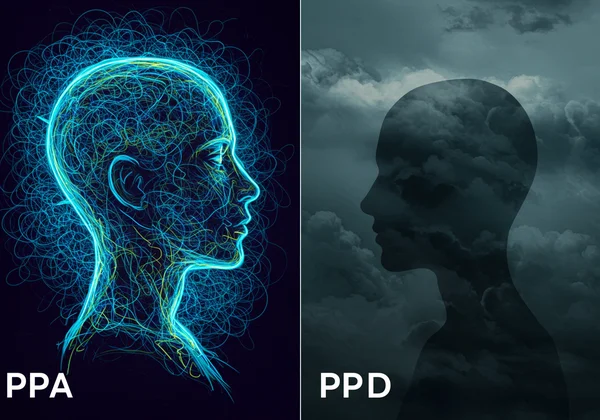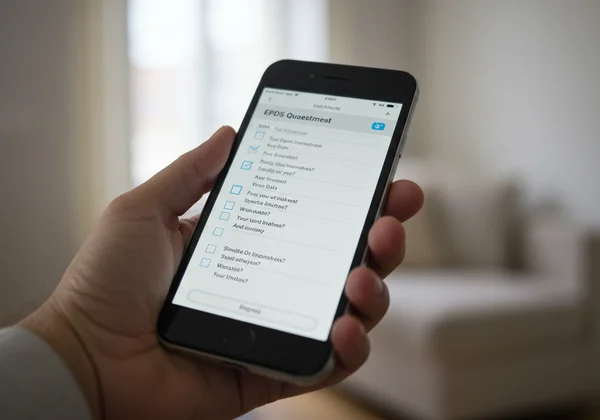โรควิตกกังวลหลังคลอด (PPA) และ EPDS: สัญญาณ อาการ และความแตกต่างจากภาวะซึมเศร้าหลังคลอด (PPD)
การเป็นแม่คือการเดินทางที่น่าทึ่ง เต็มไปด้วยช่วงเวลาที่มีความสุขสุดๆ และความท้าทายที่คาดไม่ถึง ในขณะที่สังคมมักจะมุ่งเน้นไปที่ความสุข แต่คุณแม่มือใหม่หลายคนก็ต้องเผชิญกับอารมณ์ที่ท่วมท้นอย่างเงียบๆ คุณอาจพบว่าตัวเองกังวลอยู่ตลอดเวลา ไม่สามารถผ่อนคลายได้ หรือรู้สึกถึงความหวาดกลัวที่เกาะติดอยู่ คุณจะรู้ได้อย่างไรว่าสิ่งที่คุณรู้สึกนั้นเป็นเพียงความกังวลปกติ หรือเป็นอะไรที่มากกว่านั้น เช่น โรควิตกกังวลหลังคลอด?
คู่มือฉบับนี้จะช่วยให้คุณเข้าใจและได้รับการสนับสนุน เราจะสำรวจความซับซ้อนของ โรควิตกกังวลหลังคลอด (PPA) เพื่อช่วยให้คุณระบุสัญญาณและทำความเข้าใจว่าแตกต่างจากภาวะซึมเศร้าหลังคลอด (PPD) ที่มีการพูดถึงกันอย่างแพร่หลายอย่างไร การได้รับความรู้คือก้าวแรกสู่การควบคุมสุขภาพจิตของคุณ หากคุณกำลังมองหาจุดเริ่มต้นเพื่อทำความเข้าใจความรู้สึกของตนเอง คุณสามารถ เข้ารับการคัดกรองฟรี เพื่อประเมินสภาวะอารมณ์ของคุณได้เสมอ
โรควิตกกังวลหลังคลอด (PPA) คืออะไร?
โรควิตกกังวลหลังคลอดเป็นความผิดปกติทางอารมณ์ที่อาจเกิดขึ้นกับผู้หญิงระหว่างตั้งครรภ์และหลังคลอด แม้ว่าจะเป็นเรื่องปกติที่พ่อแม่มือใหม่จะรู้สึกกังวล แต่ PPA นั้นแตกต่างออกไป โดยเกี่ยวข้องกับความวิตกกังวลที่รุนแรงและต่อเนื่องซึ่งอาจส่งผลกระทบต่อชีวิตประจำวันและความสามารถในการดูแลตนเองและลูกน้อยของคุณ ต่างจาก "ภาวะอารมณ์เศร้าหลังคลอด (baby blues)" ที่มักจะค่อยๆ หายไปภายในไม่กี่สัปดาห์ PPA อาจคงอยู่และทวีความรุนแรงขึ้นได้หากไม่ได้รับการสนับสนุนที่เหมาะสม
ภาวะนี้เป็นมากกว่าแค่ความรู้สึกเครียด แต่เกี่ยวข้องกับความคิดที่พุ่งพล่านและอาการทางร่างกายที่ท่วมท้น การทำความเข้าใจว่า PPA มีลักษณะอย่างไรเป็นสิ่งสำคัญอย่างยิ่งในการรับรู้ภาวะนี้ในตัวคุณเองหรือคนที่คุณรัก และก้าวต่อไปสู่การรู้สึกดีขึ้น

สัญญาณและอาการทั่วไปของ PPA
ประสบการณ์ของ PPA อาจแตกต่างกันไป แต่มีรูปแบบที่พบบ่อย คุณอาจรู้สึกไม่สบายใจอยู่ตลอดเวลา หรือพบว่าจิตใจของคุณเต็มไปด้วยสถานการณ์ "จะเกิดอะไรขึ้นถ้า..." ซึ่งมักจะมุ่งเน้นไปที่สุขภาพและความปลอดภัยของทารก ความคิดเหล่านี้อาจรบกวนจิตใจและควบคุมได้ยาก
นี่คือ สัญญาณ PPA ที่รายงานบ่อยที่สุด:
- ความกังวลที่ต่อเนื่อง ควบคุมไม่ได้: ความคิดวิตกกังวลที่วนเวียนอยู่ในความคิดของคุณ
- ความรู้สึกหวาดหวั่น: ความรู้สึกที่แน่วแน่ว่าจะมีสิ่งเลวร้ายเกิดขึ้น
- หงุดหงิดและกระสับกระส่าย: รู้สึกกระวนกระวายและไม่สามารถสงบลงได้
- อาการทางกาย: อาจรวมถึงหัวใจเต้นเร็ว หายใจถี่ เวียนศีรษะ คลื่นไส้ และความตึงเครียดของกล้ามเนื้อ
- การนอนหลับที่ผิดปกติ: มีปัญหาในการหลับหรือนอนหลับอย่างต่อเนื่อง แม้ว่าลูกจะหลับอยู่ก็ตาม
- การเปลี่ยนแปลงความอยากอาหาร: กินมากขึ้นหรือน้อยลงกว่าปกติ
การตระหนักถึงอาการเหล่านี้เป็นการกระทำที่สำคัญของการตระหนักรู้ในตนเอง และเป็นก้าวแรกสู่การได้รับการสนับสนุนที่คุณสมควรได้รับ
ทำความเข้าใจความวิตกกังวลหลังคลอด: มากกว่าความกังวล
ความวิตกกังวลหลังคลอด ที่เกี่ยวข้องกับ PPA นั้นเกินกว่าความกังวลทั่วไปของพ่อแม่มือใหม่ ในขณะที่คุณแม่มือใหม่อาจกังวลว่าลูกกินนมเพียงพอหรือไม่ คุณแม่ที่เป็น PPA อาจนอนไม่หลับหลายชั่วโมง จมอยู่กับความกลัวที่ไม่มีเหตุผลว่าลูกจะได้รับอันตราย ความวิตกกังวลระดับนี้ไม่ใช่เครื่องบ่งชี้ความสามารถของคุณในฐานะพ่อแม่ แต่เป็นอาการของภาวะทางการแพทย์ที่รักษาได้
ความวิตกกังวลในช่วงหลังคลอดรูปแบบนี้อาจทำให้การมีความสุขกับการเป็นแม่เป็นเรื่องยาก แทนที่จะผูกพัน คุณอาจรู้สึกห่างเหินหรือท่วมท้นไปด้วยความรับผิดชอบ สิ่งสำคัญคือต้องจำไว้ว่าคุณไม่ได้เผชิญสิ่งนี้เพียงลำพัง และมีการสนับสนุนอยู่ การสละเวลาเพื่อตรวจสอบตนเองผ่านแบบทดสอบออนไลน์ที่เป็นความลับ สามารถเป็นวิธีที่ทรงพลังในการ ทำความเข้าใจความรู้สึกของคุณ
PPA กับ PPD: ความแตกต่างที่สำคัญที่ควรรู้
แม้ว่ามักจะกล่าวถึงร่วมกัน แต่โรควิตกกังวลหลังคลอด (PPA) และภาวะซึมเศร้าหลังคลอด (PPD) เป็นภาวะที่แตกต่างกัน แม้ว่าอาจเกิดขึ้นร่วมกัน การทำความเข้าใจความแตกต่างระหว่าง PPA กับ PPD เป็นสิ่งสำคัญอย่างยิ่งสำหรับการวินิจฉัยและการรักษาที่ถูกต้อง ความแตกต่างหลักอยู่ที่ประสบการณ์ทางอารมณ์หลัก PPA นั้นเด่นชัดด้วยความกลัวและความวิตกกังวล ในขณะที่ PPD มีลักษณะเด่นคือความเศร้าและความไม่สนใจอย่างต่อเนื่อง
คุณแม่มือใหม่หลายคนรู้สึกสับสนเกี่ยวกับอารมณ์ของตนเอง โดยสงสัยว่าความวิตกกังวลที่รุนแรงของพวกเขานั้นเป็นสัญญาณของภาวะซึมเศร้าหรือไม่ แม้ว่าทั้งสองภาวะอาจมีอาการร่วมกัน เช่น ปัญหาการนอนหลับและความหงุดหงิด แต่รากฐานทางอารมณ์ของทั้งสองภาวะนั้นแตกต่างกัน การทำความเข้าใจที่ชัดเจนจะช่วยให้คุณสามารถอธิบายความรู้สึกของคุณให้ผู้ให้บริการด้านสุขภาพฟังได้ ซึ่งจะนำไปสู่การสนับสนุนที่มีประสิทธิภาพมากขึ้น

สภาวะทางอารมณ์: มากกว่าความเศร้าและความกลัว
ลองนึกภาพ PPA และ PPD เป็นสภาวะทางอารมณ์ที่แตกต่างกัน PPD มักจะรู้สึกเหมือนความรู้สึกหดหู่ เศร้าสร้อย สิ้นหวัง และว่างเปล่าอย่างหนักหน่วง คุณอาจดิ้นรนที่จะรู้สึกมีความสุข แม้ในเวลาที่คุณ "ควรจะ" มีความสุข โลกอาจดูจืดชืด และคุณอาจปลีกตัวออกจากคนที่คุณรัก
ในทางตรงกันข้าม สภาวะของ PPA คือการเตรียมพร้อมอย่างเต็มที่และความกระวนกระวายใจ มีลักษณะเด่นคือเสียงกระซิบของความวิตกกังวลอย่างต่อเนื่อง ซึ่งถูกขัดจังหวะด้วยช่วงเวลาของอาการตื่นตระหนกและความกังวลใจที่ครอบงำจิตใจ แทนที่จะรู้สึกชา คุณอาจรู้สึกกระตุ้นมากเกินไปและไม่สามารถหยุดความคิดของคุณได้ การตระหนักถึงความแตกต่างหลักใน ความวิตกกังวลในช่วงหลังคลอด นี้ เป็นกุญแจสำคัญในการค้นหาเส้นทางที่ถูกต้องไปข้างหน้า
การทับซ้อนและการเกิดร่วมกัน: ทำไมทั้งสองอย่างจึงเกิดขึ้นได้
เพื่อให้ซับซ้อนยิ่งขึ้น เป็นเรื่องปกติมากที่ PPA และ PPD จะเกิดขึ้นพร้อมกัน การวิจัยชี้ให้เห็นว่าประมาณครึ่งหนึ่งของผู้หญิงที่เป็น PPD ก็มีอาการวิตกกังวลอย่างชัดเจนเช่นกัน (เรียนรู้เพิ่มเติมเกี่ยวกับสุขภาพจิตช่วงหลังคลอดจาก NIMH) ความกังวลอย่างไม่หยุดหย่อนของ PPA อาจทำให้เหนื่อยล้า นำไปสู่ความรู้สึกสิ้นหวังที่เป็นลักษณะของ PPD ในทางกลับกัน พลังงานและแรงจูงใจที่ต่ำของ PPD อาจทำให้การจัดการกับความวิตกกังวลยากขึ้น
เนื่องจากการทับซ้อนนี้ การคัดกรองที่ครอบคลุมจึงเป็นสิ่งสำคัญ เครื่องมือที่ออกแบบมาเพื่อประเมินความผิดปกติทางอารมณ์ในช่วงหลังคลอดสามารถช่วยระบุขอบเขตอาการของคุณได้อย่างครบถ้วน ตัวอย่างเช่น การ คัดกรองภาวะซึมเศร้า EPDS เบื้องต้น สามารถให้ข้อมูลเชิงลึกที่มีคุณค่าที่คุณสามารถนำไปปรึกษากับผู้เชี่ยวชาญด้านสุขภาพได้
เมื่อใดควรขอรับการสนับสนุนด้านสุขภาพจิตในช่วงหลังคลอด
หากความรู้สึกวิตกกังวลหรือเศร้าของคุณนั้นต่อเนื่อง ท่วมท้น และส่งผลกระทบต่อความสามารถในการดำเนินชีวิตประจำวันของคุณ ก็ถึงเวลาที่ต้องขอรับการสนับสนุนด้าน สุขภาพจิตในช่วงหลังคลอด ของคุณ คุณไม่จำเป็นต้องรอจนกว่าจะถึงจุดวิกฤต การยอมรับว่าต้องการความช่วยเหลือ คือการดูแลตนเอง ไม่ใช่ความอ่อนแอ สุขภาพที่ดีของคุณเป็นสิ่งจำเป็นสำหรับทั้งตัวคุณและลูกน้อย
ช่วงเวลาหลังคลอดเป็นการเปลี่ยนแปลงครั้งใหญ่ และไม่เป็นไรที่คุณจะต้องการการสนับสนุนเพื่อรับมือกับมัน ความช่วยเหลือสามารถมาได้หลายรูปแบบ ตั้งแต่การบำบัดแบบมืออาชีพ คำแนะนำทางการแพทย์ ไปจนถึงกลยุทธ์การรับมือแบบง่ายๆ ที่คุณสามารถนำไปใช้ที่บ้าน ก้าวที่สำคัญที่สุดคือการเอื้อมมือออกไป
กลยุทธ์การรับมือเบื้องต้นสำหรับการจัดการความวิตกกังวล
แม้ว่าความช่วยเหลือจากผู้เชี่ยวชาญจะมีความสำคัญอย่างยิ่งต่อการรักษา PPA แต่ก็มี กลยุทธ์การรับมือเบื้องต้น หลายอย่างที่คุณสามารถใช้เพื่อจัดการกับอาการในขณะนั้น เทคนิคเหล่านี้สามารถช่วยให้คุณสงบลงได้เมื่อคุณรู้สึกท่วมท้น
- การหายใจอย่างมีสติ: เมื่อคุณรู้สึกหัวใจเต้นเร็ว ให้จดจ่อกับการหายใจเข้าลึกๆ ช้าๆ หายใจเข้า 4 จังหวะ กลั้นไว้ 4 จังหวะ และหายใจออก 6 จังหวะ สิ่งนี้สามารถช่วยให้ระบบประสาทของคุณสงบลงได้
- พูดคุยเกี่ยวกับมัน: แบ่งปันความรู้สึกของคุณกับคู่รัก เพื่อน หรือสมาชิกในครอบครัวที่คุณไว้ใจ การพูดความกลัวของคุณออกมาสามารถลดพลังของมันลงได้
- การเคลื่อนไหวอย่างนุ่มนวล: การเดินเล่นสั้นๆ นอกบ้านสามารถช่วยให้จิตใจปลอดโปร่งและลดความรู้สึกกระสับกระส่ายได้
- จดจ่อกับประสาทสัมผัส: เมื่อความคิดของคุณพุ่งพล่าน ให้ยึดตัวเองอยู่กับปัจจุบัน บอก 5 สิ่งที่คุณมองเห็น 4 สิ่งที่คุณรู้สึก 3 สิ่งที่คุณได้ยิน 2 สิ่งที่คุณได้กลิ่น และ 1 สิ่งที่คุณได้รสชาติ
กลยุทธ์เหล่านี้เป็นเครื่องมือ ไม่ใช่การรักษา แต่สามารถให้ความโล่งใจในทันทีและเสริมพลังให้คุณจัดการกับช่วงเวลาที่ยากลำบากได้

บทบาทของเครื่องมือคัดกรองเช่น EPDS ในการประเมิน
เครื่องมือคัดกรองเป็นก้าวแรกที่สำคัญในการระบุความผิดปกติทางอารมณ์และวิตกกังวลในช่วงหลังคลอด แบบประเมินภาวะซึมเศร้าหลังคลอดเอดินบะระ (Edinburgh Postnatal Depression Scale - EPDS) เป็นแบบสอบถามที่ได้รับการยอมรับทั่วโลก ออกแบบมาเพื่อตรวจจับอาการของ PPD แม้ว่าชื่อจะเน้นที่ภาวะซึมเศร้า แต่คำถามหลายข้อในแบบสอบถาม โดยเฉพาะอย่างยิ่งคำถามเกี่ยวกับความรู้สึกวิตกกังวล กังวลใจ และตำหนิตนเอง สามารถบ่งชี้ถึงความเสี่ยงของ PPA ได้เช่นกัน
การเข้ารับ การคัดกรอง EPDS ฟรี ทางออนไลน์อย่างเป็นความลับ เป็นวิธีที่รวดเร็วและเป็นส่วนตัวในการประเมินอาการของคุณ ผลลัพธ์จะให้จุดเริ่มต้นที่เป็นรูปธรรมสำหรับการสนทนากับแพทย์หรือผู้เชี่ยวชาญด้านสุขภาพจิตของคุณ เปลี่ยนความรู้สึกคลุมเครือให้เป็นข้อมูลที่วัดผลได้ ช่วยให้คุณดูแลสุขภาพของตนเองได้ คุณสามารถ เริ่มการคัดกรองของคุณได้ทันที เพื่อทำความเข้าใจสุขภาพอารมณ์ของคุณได้ดีขึ้น

ควบคุมชีวิต: ก้าวต่อไปสู่สุขภาพที่ดีหลังคลอด
ในขณะที่คุณรับมือกับความท้าทายทางอารมณ์ของการเป็นแม่ โปรดจำไว้ว่าคุณไม่จำเป็นต้องทำเพียงลำพัง การทำความเข้าใจสัญญาณของโรควิตกกังวลหลังคลอดและวิธีที่แตกต่างจาก PPD เป็นการเสริมพลังตนเองที่สำคัญ PPA เป็นภาวะที่เกิดขึ้นจริง พบได้ทั่วไป และรักษาได้ดี การตระหนักถึงอาการ สำรวจกลยุทธ์การรับมือ และรู้ว่าเมื่อใดควรขอความช่วยเหลือ คือการที่คุณกำลังควบคุมสุขภาพที่ดีหลังคลอดของคุณ
โปรดจำไว้ว่าสุขภาพจิตของคุณเป็นสิ่งสำคัญ การใช้เครื่องมือคัดกรองที่เป็นความลับสามารถเป็นก้าวแรกที่ยอดเยี่ยมในการทำความเข้าใจสิ่งที่คุณกำลังประสบ เราขอแนะนำให้คุณ เยี่ยมชมหน้าแรกของเรา เพื่อเข้ารับการคัดกรอง EPDS ฟรีที่อิงตามหลักวิทยาศาสตร์ แบ่งปันผลลัพธ์ของคุณกับผู้ให้บริการด้านสุขภาพเพื่อสร้างแผนการดูแลสุขภาพที่ดีของคุณ
คำถามที่พบบ่อยเกี่ยวกับความวิตกกังวลในช่วงหลังคลอดและการคัดกรอง
EPDS คัดกรองภาวะวิตกกังวลหรือไม่?
แม้ว่าแบบประเมินภาวะซึมเศร้าหลังคลอดเอดินบะระ (EPDS) จะออกแบบมาเพื่อคัดกรองภาวะซึมเศร้าเป็นหลัก แต่ก็สามารถระบุภาวะวิตกกังวลได้อย่างมีประสิทธิภาพเช่นกัน คำถามหลายข้อในแบบสอบถาม โดยเฉพาะอย่างยิ่งคำถามเกี่ยวกับความรู้สึกวิตกกังวล หรือกังวลใจโดยไม่มีเหตุผลอันควร สามารถบ่งชี้ถึงความเสี่ยงของ PPA ได้ คะแนนสูงมักต้องการการประเมินอย่างละเอียดสำหรับทั้งภาวะซึมเศร้าและวิตกกังวล
คะแนน EPDS ปกติคือเท่าใด?
ไม่มีคะแนน "ปกติ" เพียงคะแนนเดียว แต่มีช่วงคะแนนที่บ่งชี้ระดับความเสี่ยงที่แตกต่างกัน โดยทั่วไป คะแนน 0-8 ถือว่ามีความเสี่ยงต่ำ คะแนน 9-11 บ่งชี้ถึงความเป็นไปได้ของภาวะซึมเศร้าเล็กน้อย ในขณะที่คะแนน 12 หรือสูงกว่า บ่งชี้ถึงความเสี่ยงที่สูงต่อโรคซึมเศร้า และแนะนำอย่างยิ่งให้ปรึกษาผู้เชี่ยวชาญ เพื่อดูว่าคะแนนของคุณอยู่ในระดับใด คุณสามารถ รับคะแนน EPDS ของคุณ ได้อย่างเป็นความลับ
แบบทดสอบ EPDS ใช้เวลานานเท่าใด?
แบบทดสอบ EPDS ออกแบบมาให้รวดเร็วและตรงไปตรงมา ประกอบด้วย 10 คำถาม และโดยทั่วไปจะใช้เวลาเพียง 3 ถึง 5 นาทีในการทำให้เสร็จ ทำให้เป็นก้าวแรกที่เข้าถึงได้สำหรับพ่อแม่มือใหม่ที่ยุ่ง เพื่อตรวจสอบสุขภาพจิตของตนเองโดยไม่ต้องใช้เวลามากนัก
ควรทำอย่างไรหลังจากได้คะแนน EPDS สูง?
การได้รับคะแนน EPDS สูงไม่ใช่การวินิจฉัย แต่เป็นสัญญาณสำคัญที่บ่งชี้ว่าควรปรึกษาผู้เชี่ยวชาญ ก้าวแรกและสำคัญที่สุดคือการนัดหมายกับผู้ให้บริการด้านสุขภาพของคุณ เช่น สูติแพทย์ แพทย์ทั่วไป หรือผู้เชี่ยวชาญด้านสุขภาพจิต แบ่งปันคะแนนและอาการของคุณกับพวกเขา เพื่อหารือเกี่ยวกับขั้นตอนต่อไปที่ดีที่สุด ซึ่งอาจรวมถึงการบำบัด ยา หรือบริการสนับสนุนอื่นๆ